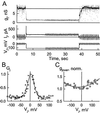Coupling asymmetry of heterotypic connexin 45/ connexin 43-EGFP gap junctions: properties of fast and slow gating mechanisms
- PMID: 12011467
- PMCID: PMC124537
- DOI: 10.1073/pnas.032062099
Coupling asymmetry of heterotypic connexin 45/ connexin 43-EGFP gap junctions: properties of fast and slow gating mechanisms
Erratum in
- Proc Natl Acad Sci U S A 2002 Jul 23;99(15):10228
Abstract
Although fast and slow gating mechanisms have been described in gap junctions (GJs), their relative contributions to dependence on transjunctional voltage, V(j), is still unclear. We used cell lines expressing wild-type connexin 45 (Cx45) and connexin 43 fused with enhanced green fluorescent protein (Cx43-EGFP) to examine mechanisms of gating in homo- and heterotypic GJs formed of these connexins. Macroscopically Cx45/Cx45 channels show high sensitivity to V(j). Cx45 channels demonstrate two types of gating: fast transitions between open and residual states and slow transitions between open and completely closed states. Single-channel conductance of the Cx45 channel is approximately 32 pS for the open state and approximately 4 pS for the residual state. Cx45/Cx43-EGFP heterotypic junctions exhibit very asymmetrical V(j) gating with the maximum junctional conductance shifted to V(j) positive on the Cx45 side. Conductance of single Cx45/Cx43-EGFP channels is approximately 55 pS for the open state and approximately 4 pS for the residual state, values consistent with the simple-series connection of Cx45 and Cx43-EGFP hemichannels. At V(j) = 0, the slow gate of many Cx45 hemichannels is closed in both homotypic Cx45/Cx45 and heterotypic Cx45/Cx43-EGFP junctions. Fast and slow V(j) gates of both Cx45 and Cx43 hemichannels close for relative negativity at their cytoplasmic end. Coupling mediated by Cx45/Cx43-EGFP junctions can exhibit asymmetry that can be strongly modulated by small changes in difference of holding potentials. Cx45/Cx43 junctions are likely to be found in brain and heart and may mediate rectifying electrical transmission or modulatable chemical communication.
Figures






References
Publication types
MeSH terms
Substances
Grants and funding
LinkOut - more resources
Full Text Sources
Miscellaneous

